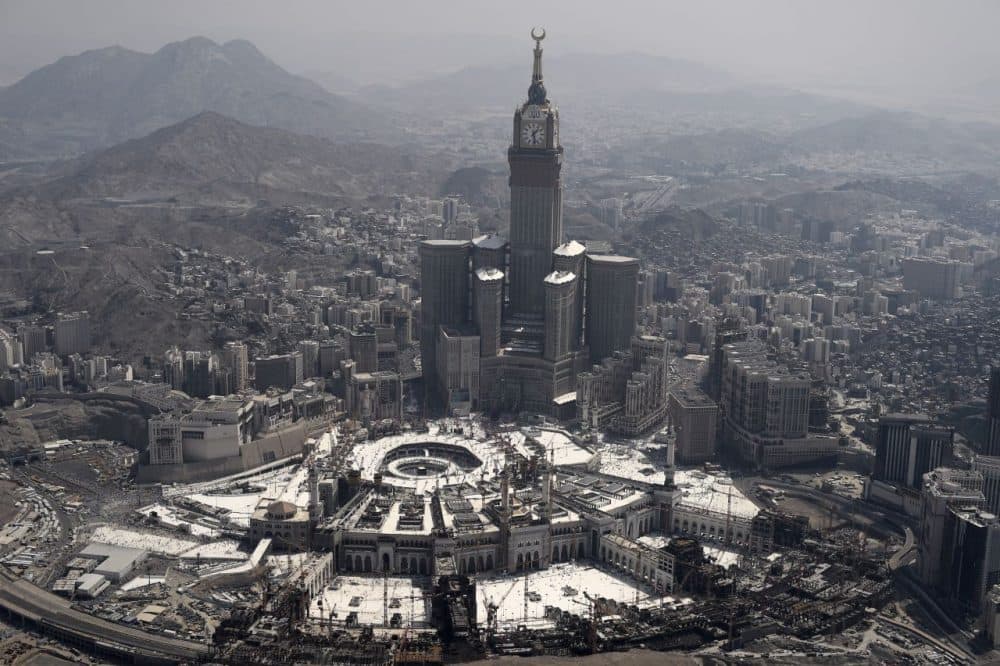Advertisement
Changing Mecca Creates Hajj 'Haves' And 'Have Nots'
Resume
Muslim pilgrims somberly resumed the rituals of the final day of the hajj on Friday, following the deaths of at least 700 people who were trampled as two waves of pilgrims collided in Mecca's deadliest disaster in 25 years.
The latest tragedy comes less than two weeks after 107 people were killed in Mecca when a crane collapsed outside the Grand Mosque. As officials continue to investigate that accident, some have questioned the need to expand the Grand Mosque — already the largest in the world, covering more than 88 acres.
Rosie Bsheer teaches history at Yale University and is a co-editor of the online journal Jadaliyya, where she recently published "The Property Regime: Mecca and the Politics of Redevelopment in Saudi Arabia." She joins Here & Now's Meghna Chakrabarti to discuss the profound effects of development in Mecca.
Interview Highlights
On the changes in Mecca’s appearance since the First Gulf War
“Well there was a global recession immediately after the 1991 Gulf War, which was worsened by the 1997 Asian economic crisis, so investing Saudi capital abroad was no longer as profitable as it had been in earlier decades. In order for the Saudi regime to keep capital locally, what it did is invest its own capital in land and property, first starting in Mecca – more specifically starting with the development of King Abdullah bin Abdulaziz’s endowment project, which is basically the complex that today houses Mecca’s clock tower … I mention this project because it was the engine that basically propelled the massive redevelopment of central mecca, and encouraged global capital to invest in the city despite the global economic stagnation. So, under the Saudi Binladen group, which has since the 1950s basically overseen all the development projects in central Mecca, redevelopment there has been purely driven by capital interest and profits.”
On the physical appearance of Mecca today
“Since the late 1990s specifically, urban redevelopment has overhauled the city’s physical landscape, with the wholesale destruction of the neighborhoods immediately surrounding the Grand Mosque. Some parts have been developed, others still look like craters. When you go to Mecca today it’s quite jarring, you are surrounded by construction, cranes overlook people – specifically when you are inside the Grand Mosque – but throughout central Mecca there are cranes all over the place. The air quality is quite bad, pollution is rampant. Traffic is quite awful because of the lack of proper planning. This has been a problem in Mecca in the last 15 years I would say.”
On heightening disparities between wealthy and non-wealthy pilgrims
“First and foremost, the new Mecca affects the longtime residents of the city, many of whom have been forced to leave their homes, homes that in most cases have been passed down from one generation to another. Those who have been evicted from their homes have received meager compensation in return. Many have ended up in slums and are still homeless. Now the new Mecca is designed with maximizing profits in mind, so it is meant for the rich and affluent, which has in turn driven prices up which affects both residents and pilgrims."
"The Saudi regime has recently paid lip service to the idea of affordable housing for non-wealthy pilgrims, but there simply is no incentive for them to do so given the remarkable profit margins on upscale accommodations."
"In terms of the hajj itself, this means that it has become increasingly difficult for pilgrims without means to secure affordable accommodations, because many of these have been destroyed and been replaced by luxury hotels and apartment complexes which we see regularly in the media lately. Those without means now have to live even further away from central Mecca, making the hajj even more difficult for them in terms of affordability, but also transportation and logistics. The Saudi regime has recently paid lip service to the idea of affordable housing for non-wealthy pilgrims, but there simply is no incentive for them to do so given the remarkable profit margins on upscale accommodations.”
On pushback against the expansion of Mecca
“Since the late 1990s, the Saudi regime has stressed the speed of construction at the expense of everything else. And the Saudi Binladen Group in charge of redevelopment in Mecca has been more than willing to comply, again given the profits that they are generating. This has come at the expense of safe and smart planning, and the Binladen Group has time and again compromised on implementing safety standards in order to cut on costs and time, of course with the complete knowledge of Saudi rulers. Now this, in addition to the large number of pilgrims the Saudi regime has allowed, has created a recipe for disaster."
"But other than these major disasters, people inside and outside of Saudi Arabia rarely hear about the regular accidents that occur in Mecca, from fires to collapsing buildings. Yet many Saudis in Mecca have sensed for at least a decade that redevelopment in Mecca is poorly planned and not going in the direction they want. Of course, there have been groups calling on better and more sustainable developments of the city since the 1970s and to the surprise of many people there have been voices even among the religious establishment in Saudi Arabia that have been critical of the trajectory of the development as well, but the regime has rarely heeded their advice.”
Guest
- Rosie Bsheer, history professor at Yale University and co-editor of Jadaliyya, an online journal.
This segment aired on September 25, 2015.